Ranga Rodrigo
University of Moratuwa
Uncertainty Awareness Enables Efficient Labeling for Cancer Subtyping in Digital Pathology
Jun 13, 2025Abstract:Machine-learning-assisted cancer subtyping is a promising avenue in digital pathology. Cancer subtyping models, however, require careful training using expert annotations so that they can be inferred with a degree of known certainty (or uncertainty). To this end, we introduce the concept of uncertainty awareness into a self-supervised contrastive learning model. This is achieved by computing an evidence vector at every epoch, which assesses the model's confidence in its predictions. The derived uncertainty score is then utilized as a metric to selectively label the most crucial images that require further annotation, thus iteratively refining the training process. With just 1-10% of strategically selected annotations, we attain state-of-the-art performance in cancer subtyping on benchmark datasets. Our method not only strategically guides the annotation process to minimize the need for extensive labeled datasets, but also improves the precision and efficiency of classifications. This development is particularly beneficial in settings where the availability of labeled data is limited, offering a promising direction for future research and application in digital pathology.
Feature Modulation for Semi-Supervised Domain Generalization without Domain Labels
Mar 26, 2025



Abstract:Semi-supervised domain generalization (SSDG) leverages a small fraction of labeled data alongside unlabeled data to enhance model generalization. Most of the existing SSDG methods rely on pseudo-labeling (PL) for unlabeled data, often assuming access to domain labels-a privilege not always available. However, domain shifts introduce domain noise, leading to inconsistent PLs that degrade model performance. Methods derived from FixMatch suffer particularly from lower PL accuracy, reducing the effectiveness of unlabeled data. To address this, we tackle the more challenging domain-label agnostic SSDG, where domain labels for unlabeled data are not available during training. First, we propose a feature modulation strategy that enhances class-discriminative features while suppressing domain-specific information. This modulation shifts features toward Similar Average Representations-a modified version of class prototypes-that are robust across domains, encouraging the classifier to distinguish between closely related classes and feature extractor to form tightly clustered, domain-invariant representations. Second, to mitigate domain noise and improve pseudo-label accuracy, we introduce a loss-scaling function that dynamically lowers the fixed confidence threshold for pseudo-labels, optimizing the use of unlabeled data. With these key innovations, our approach achieves significant improvements on four major domain generalization benchmarks-even without domain labels. We will make the code available.
DARB-Splatting: Generalizing Splatting with Decaying Anisotropic Radial Basis Functions
Jan 21, 2025Abstract:Splatting-based 3D reconstruction methods have gained popularity with the advent of 3D Gaussian Splatting, efficiently synthesizing high-quality novel views. These methods commonly resort to using exponential family functions, such as the Gaussian function, as reconstruction kernels due to their anisotropic nature, ease of projection, and differentiability in rasterization. However, the field remains restricted to variations within the exponential family, leaving generalized reconstruction kernels largely underexplored, partly due to the lack of easy integrability in 3D to 2D projections. In this light, we show that a class of decaying anisotropic radial basis functions (DARBFs), which are non-negative functions of the Mahalanobis distance, supports splatting by approximating the Gaussian function's closed-form integration advantage. With this fresh perspective, we demonstrate up to 34% faster convergence during training and a 15% reduction in memory consumption across various DARB reconstruction kernels, while maintaining comparable PSNR, SSIM, and LPIPS results. We will make the code available.
Test-Time Optimization for Domain Adaptive Open Vocabulary Segmentation
Jan 08, 2025Abstract:We present Seg-TTO, a novel framework for zero-shot, open-vocabulary semantic segmentation (OVSS), designed to excel in specialized domain tasks. While current open vocabulary approaches show impressive performance on standard segmentation benchmarks under zero-shot settings, they fall short of supervised counterparts on highly domain-specific datasets. We focus on segmentation-specific test-time optimization to address this gap. Segmentation requires an understanding of multiple concepts within a single image while retaining the locality and spatial structure of representations. We propose a novel self-supervised objective adhering to these requirements and use it to align the model parameters with input images at test time. In the textual modality, we learn multiple embeddings for each category to capture diverse concepts within an image, while in the visual modality, we calculate pixel-level losses followed by embedding aggregation operations specific to preserving spatial structure. Our resulting framework termed Seg-TTO is a plug-in-play module. We integrate Seg-TTO with three state-of-the-art OVSS approaches and evaluate across 22 challenging OVSS tasks covering a range of specialized domains. Our Seg-TTO demonstrates clear performance improvements across these establishing new state-of-the-art. Code: https://github.com/UlinduP/SegTTO.
A Feature Generator for Few-Shot Learning
Sep 21, 2024

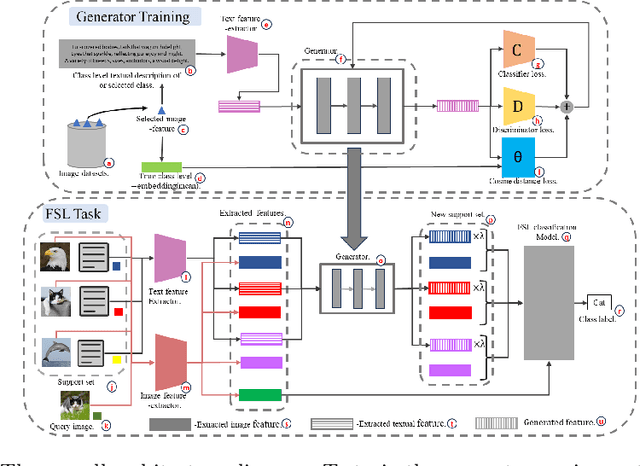

Abstract:Few-shot learning (FSL) aims to enable models to recognize novel objects or classes with limited labelled data. Feature generators, which synthesize new data points to augment limited datasets, have emerged as a promising solution to this challenge. This paper investigates the effectiveness of feature generators in enhancing the embedding process for FSL tasks. To address the issue of inaccurate embeddings due to the scarcity of images per class, we introduce a feature generator that creates visual features from class-level textual descriptions. By training the generator with a combination of classifier loss, discriminator loss, and distance loss between the generated features and true class embeddings, we ensure the generation of accurate same-class features and enhance the overall feature representation. Our results show a significant improvement in accuracy over baseline methods, with our approach outperforming the baseline model by 10% in 1-shot and around 5% in 5-shot approaches. Additionally, both visual-only and visual + textual generators have also been tested in this paper.
LiverUSRecon: Automatic 3D Reconstruction and Volumetry of the Liver with a Few Partial Ultrasound Scans
Jun 27, 2024Abstract:3D reconstruction of the liver for volumetry is important for qualitative analysis and disease diagnosis. Liver volumetry using ultrasound (US) scans, although advantageous due to less acquisition time and safety, is challenging due to the inherent noisiness in US scans, blurry boundaries, and partial liver visibility. We address these challenges by using the segmentation masks of a few incomplete sagittal-plane US scans of the liver in conjunction with a statistical shape model (SSM) built using a set of CT scans of the liver. We compute the shape parameters needed to warp this canonical SSM to fit the US scans through a parametric regression network. The resulting 3D liver reconstruction is accurate and leads to automatic liver volume calculation. We evaluate the accuracy of the estimated liver volumes with respect to CT segmentation volumes using RMSE. Our volume computation is statistically much closer to the volume estimated using CT scans than the volume computed using Childs' method by radiologists: p-value of 0.094 (>0.05) says that there is no significant difference between CT segmentation volumes and ours in contrast to Childs' method. We validate our method using investigations (ablation studies) on the US image resolution, the number of CT scans used for SSM, the number of principal components, and the number of input US scans. To the best of our knowledge, this is the first automatic liver volumetry system using a few incomplete US scans given a set of CT scans of livers for SSM.
Vessel Re-identification and Activity Detection in Thermal Domain for Maritime Surveillance
Jun 12, 2024



Abstract:Maritime surveillance is vital to mitigate illegal activities such as drug smuggling, illegal fishing, and human trafficking. Vision-based maritime surveillance is challenging mainly due to visibility issues at night, which results in failures in re-identifying vessels and detecting suspicious activities. In this paper, we introduce a thermal, vision-based approach for maritime surveillance with object tracking, vessel re-identification, and suspicious activity detection capabilities. For vessel re-identification, we propose a novel viewpoint-independent algorithm which compares features of the sides of the vessel separately (separate side-spaces) leveraging shape information in the absence of color features. We propose techniques to adapt tracking and activity detection algorithms for the thermal domain and train them using a thermal dataset we created. This dataset will be the first publicly available benchmark dataset for thermal maritime surveillance. Our system is capable of re-identifying vessels with an 81.8% Top1 score and identifying suspicious activities with a 72.4\% frame mAP score; a new benchmark for each task in the thermal domain.
Contrastive Deep Encoding Enables Uncertainty-aware Machine-learning-assisted Histopathology
Sep 13, 2023



Abstract:Deep neural network models can learn clinically relevant features from millions of histopathology images. However generating high-quality annotations to train such models for each hospital, each cancer type, and each diagnostic task is prohibitively laborious. On the other hand, terabytes of training data -- while lacking reliable annotations -- are readily available in the public domain in some cases. In this work, we explore how these large datasets can be consciously utilized to pre-train deep networks to encode informative representations. We then fine-tune our pre-trained models on a fraction of annotated training data to perform specific downstream tasks. We show that our approach can reach the state-of-the-art (SOTA) for patch-level classification with only 1-10% randomly selected annotations compared to other SOTA approaches. Moreover, we propose an uncertainty-aware loss function, to quantify the model confidence during inference. Quantified uncertainty helps experts select the best instances to label for further training. Our uncertainty-aware labeling reaches the SOTA with significantly fewer annotations compared to random labeling. Last, we demonstrate how our pre-trained encoders can surpass current SOTA for whole-slide image classification with weak supervision. Our work lays the foundation for data and task-agnostic pre-trained deep networks with quantified uncertainty.
3DLatNav: Navigating Generative Latent Spaces for Semantic-Aware 3D Object Manipulation
Nov 17, 2022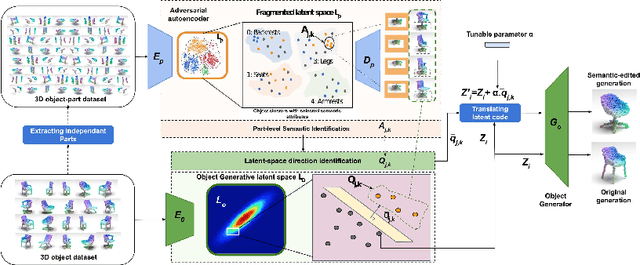
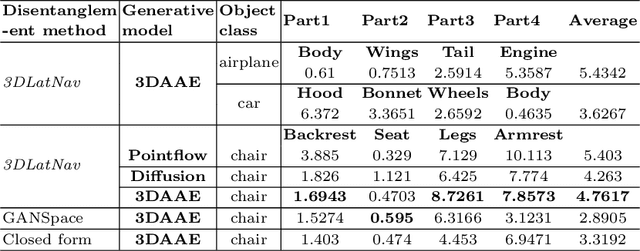
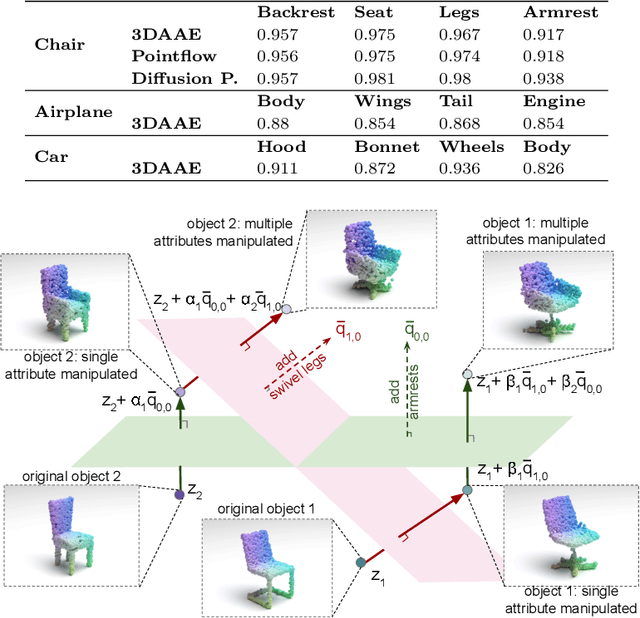
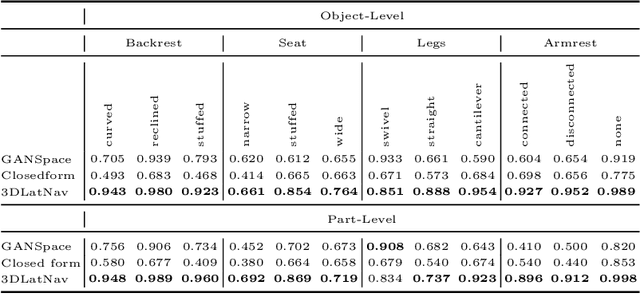
Abstract:3D generative models have been recently successful in generating realistic 3D objects in the form of point clouds. However, most models do not offer controllability to manipulate the shape semantics of component object parts without extensive semantic attribute labels or other reference point clouds. Moreover, beyond the ability to perform simple latent vector arithmetic or interpolations, there is a lack of understanding of how part-level semantics of 3D shapes are encoded in their corresponding generative latent spaces. In this paper, we propose 3DLatNav; a novel approach to navigating pretrained generative latent spaces to enable controlled part-level semantic manipulation of 3D objects. First, we propose a part-level weakly-supervised shape semantics identification mechanism using latent representations of 3D shapes. Then, we transfer that knowledge to a pretrained 3D object generative latent space to unravel disentangled embeddings to represent different shape semantics of component parts of an object in the form of linear subspaces, despite the unavailability of part-level labels during the training. Finally, we utilize those identified subspaces to show that controllable 3D object part manipulation can be achieved by applying the proposed framework to any pretrained 3D generative model. With two novel quantitative metrics to evaluate the consistency and localization accuracy of part-level manipulations, we show that 3DLatNav outperforms existing unsupervised latent disentanglement methods in identifying latent directions that encode part-level shape semantics of 3D objects. With multiple ablation studies and testing on state-of-the-art generative models, we show that 3DLatNav can implement controlled part-level semantic manipulations on an input point cloud while preserving other features and the realistic nature of the object.
Realistic, Animatable Human Reconstructions for Virtual Fit-On
Oct 16, 2022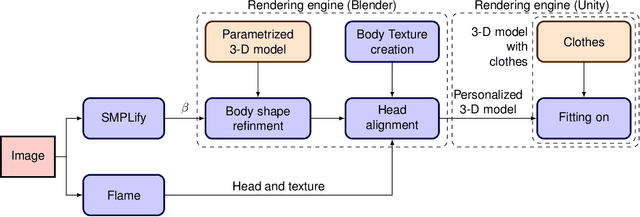

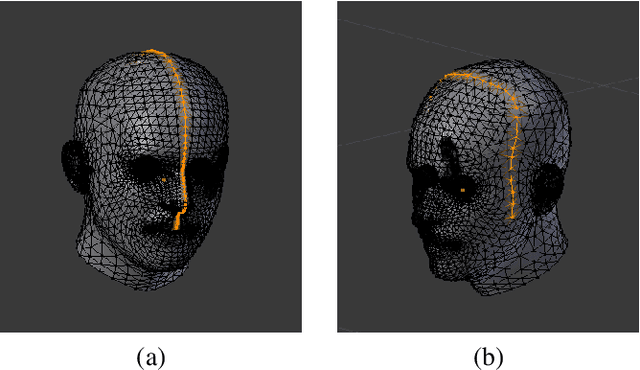
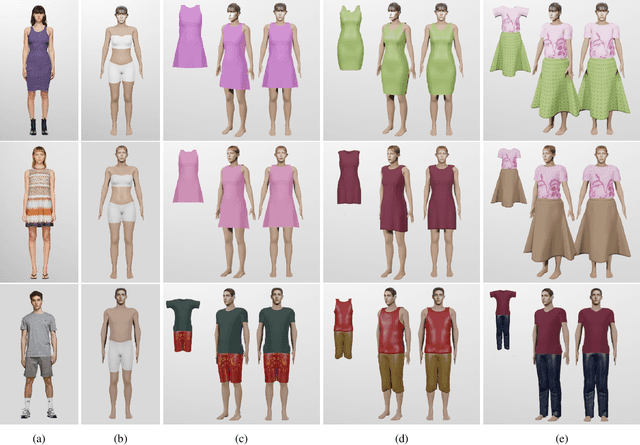
Abstract:We present an end-to-end virtual try-on pipeline, that can fit different clothes on a personalized 3-D human model, reconstructed using a single RGB image. Our main idea is to construct an animatable 3-D human model and try-on different clothes in a 3-D virtual environment. The existing frame by frame volumetric reconstruction of 3-D human models are highly resource-demanding and do not allow clothes switching. Moreover, existing virtual fit-on systems also lack realism due to predominantly being 2-D or not using user's features in the reconstruction. These shortcomings are due to either the human body or clothing model being 2-D or not having the user's facial features in the dressed model. We solve these problems by manipulating a parametric representation of the 3-D human body model and stitching a head model reconstructed from the actual image. Fitting the 3-D clothing models on the parameterized human model is also adjustable to the body shape of the input image. Our reconstruction results, in comparison with recent existing work, are more visually-pleasing.
 Add to Chrome
Add to Chrome Add to Firefox
Add to Firefox Add to Edge
Add to Edge